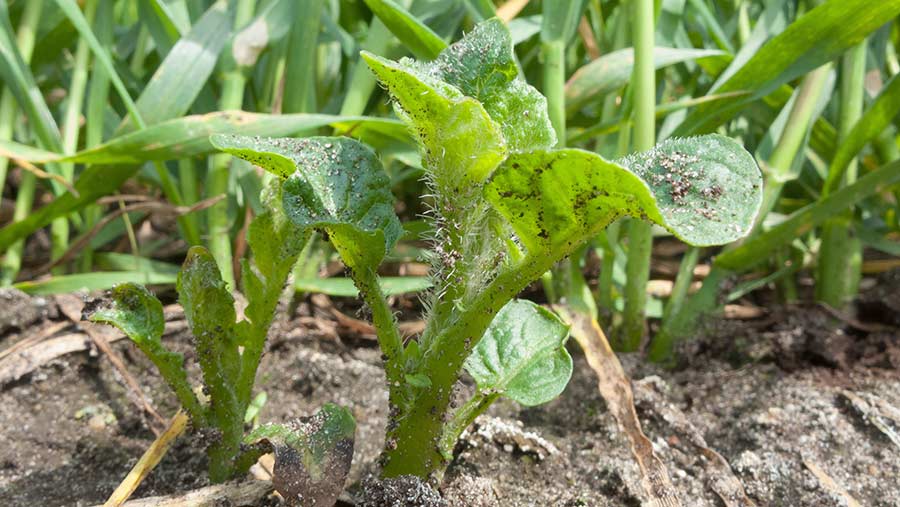Why cultural control is key to keeping potato blight at bay
 © Blackthorn Arable
© Blackthorn Arable The strains of blight that potato growers face in protecting their crops are becoming ever more aggressive, as only the fittest survive.
A good example is the recent strain 36A2. It is very capable of taking a crop down quickly, and even managed it in the heat of the 2018 summer. All it needs is some leaf wetness.
Blight can change very rapidly, meaning these robust new strains are appearing in the wider population on a frequent basis.
See also: 3 fungicide strategies to fight resistant potato blight
Unlike aggressive foliar diseases in cereals, which reduce yield but leave at least something to sell, potato blight can destroy leaves, stems and tubers.
For this reason most growers employ a suitably rigorous spray programme to keep this ever-increasing threat at bay.
But they may be overlooking weak links created by poor cultural control, with potato dumps, volunteers and cover crops all potentially harbouring the water mould.
Site, variety and weather are all key factors which could potentially undermine a good spray programme.
3 factors that can undermine good fungicide spray programmes
Site
This is made up of the field and its surroundings. The risk increases when crops are surrounded by gardens, allotments or trees, but a stock feed heap can be easily missed.
Other site influences are poor seed or soil management which leads to uneven emergence.
Variety
It is interesting how a variety can have good foliar blight resistance, but the tubers are very susceptible, or vice-versa. Make sure you are aware of both risks.
Resistance is something that we do not always know enough about until it is too late. Treat a new variety with extreme caution unless you have good reliable information.
Weather
When it is dull, overcast and drizzling all day in summer it is high risk weather. It might feel cold, but it is rarely too cold for blight on a summer’s day. Any rain in the evening ensures a good long spell of high relative humidity overnight.
It is important to sign up for disease alerts, but also be ready to close up spray intervals ahead of a high-risk period.
Another aspect that is particularly difficult to manage is the unknown quantity of spores in the ridge at the end of the season, and whether they are able to attack the tubers.
Therefore, we need to keep monitoring crop health even after all the haulm is completely dead, especially as growers will need to use alternatives to diquat after this season.
High-risk volunteers
Volunteer potatoes are incredibly capable of surviving all manner of things, such as cultivations, disease, frost, wet and herbicides.
It is fair to say that if a field has grown spuds in the past 8-10 years, there will be a few lurking under the surface.
Volunteer potatoes must be treated as high risk as they may start an infection within the crop. They also host other things such as rhizoctonia, black dot and virus, so getting rid of them is a high priority.
It is vital to check for volunteer potatoes in the field margins, possibly placed there by de-clodders, in field margin strips or game cover.
Any potato in the field that is beyond the reach of the sprayer must be controlled. It is amazing where they turn up and how well they grow. Even a straw bale will support quite a few.
Cover crops
Another aspect of cultural control which is frequently overlooked is that of volunteers in the autumn pre-cropping, as these are a potential time-bomb.
If volunteers are left uncontrolled, they will normally become infected with blight.
The combination of new growth, suitable infection conditions and the absence of fungicides makes this almost inevitable.
Tuber blight infection is highly likely in this situation and although only a small percentage are likely to produce an infected volunteer, it takes only one.
The issue of oospore infection should not be ignored either, it is an important factor in similar latitudes, particularly for northern growers.
Growing a cover crop ahead of potatoes is becoming popular for soil improvement, but if a significant volunteer population exists, it may be better to move the cover crop elsewhere in the rotation – the benefits may be greater after the following cereal crop.
Plan for late control
This autumn will be the last for diquat use in potato crops, and this brings another challenge for growers.
With existing alternatives to diquat, burn down will be slower and this will make things tricky at the tail end of the season.
Any crop with strong haulm growth at harvest will really need flailing to stop it quickly. This, combined with the alternatives to diquat, should do a decent job.
In the absence of flailing it will be a different affair and unless the haulm is running out of steam, death will be slow.
Fungicides with known tuber blight activity need to be used while the crop is still green, and if it stays green for longer, this means more fungicide applications.
Unfortunately, the options are limited and from a small number of resistance groups.
The best advice is to look at what can be used, plan for late season tuber blight control and make sure enough of these are held back.
However, fluazinam no longer provides the simple answer at the end of the season that it used to.
There is always the option to adjust nitrogen dose to try to manage the crop, particularly with indeterminate varieties, but in reality this is notoriously difficult to do.
Martyn Cox is an independent agronomist specialising in potatoes

